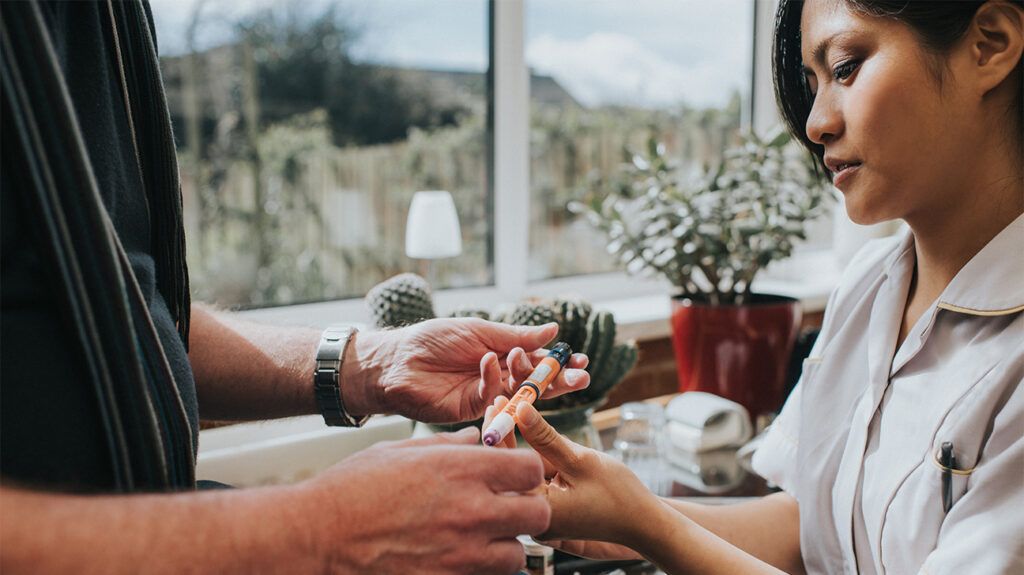Diabetes can change your life, so if you’re living with the condition, it’s only natural you may look for a cure.
There are two main types of diabetes — types 1 and 2.
Type 1 diabetes is an autoimmune disorder where the body does not produce enough insulin. Insulin is a hormone that helps regulate your blood sugar levels. The condition is mostly diagnosed in children, but sometimes in adults too.
Type 2 is a metabolic disorder in which your pancreas doesn’t respond well to or produce enough insulin. Risk factors include genetics, having a higher body mass index (BMI), and reduced exercise levels.
Currently, there is no cure for either type 1 or type 2 diabetes. Still, there are several ways you can manage the condition to live a healthy life.
Is there a cure for diabetes?

Diabetes is very common. Estimates suggest that more than 1 in 10 people in the United States live with the condition. It also affects more than 8% of people worldwide. Over 90% of diabetes cases are type 2.
Research to find a cure for diabetes is ongoing, exploring things like beta cell treatment and immunotherapy. However, to date, there is no cure for diabetes.
Thankfully, you can still live a long and healthy life through diabetes management tailored to your lifestyle, symptoms, and diabetes type and severity.
Regardless of diabetes type, the key to effective management is to manage your blood sugar levels through a combination of lifestyle strategies and medications.
Type 1 diabetes treatment options
Management for type 1 diabetes is most often via blood sugar monitoring and insulin injections.
Some people use a combined blood sugar monitor and insulin pump to make it easier to stay on top of blood sugar levels throughout the day.
Following a balanced diet and regular exercise regimen can also help. For instance, a small 2018 study demonstrated that cardio and resistance training could improve blood sugar management in adults with type 1 diabetes.
Type 2 diabetes treatment options
Like type 1, managing type 2 diabetes sometimes includes the use of insulin monitoring and injections. You may also be able to manage the condition solely by following a balanced diet and ensuring regular exercise.
Many large-scale reviews agree that regular cardio and resistance exercise is essential for the management of type 2 diabetes — as long as the type and intensity don’t increase the risk of injury or heart conditions.
When it comes to diet, a 2019 review explored how some people with type 2 diabetes benefit from a low carbohydrate approach. Meanwhile, a 2020 review describes how others use a Mediterranean diet.
Weight loss is another way you may be able to reduce the effects of type 2 diabetes.
For instance, a 2018 study involving 306 people with obesity and type 2 diabetes found that a weight loss of 15 kilograms — around 33 pounds — was linked to remission of the condition for some. Some people also opt for surgical options for weight loss for diabetes management.
A doctor can prescribe certain medications for type 2 diabetes, including:
- Metformin: This helps your body use insulin more efficiently.
- Sulfonylureas: These drug types stimulate your pancreas to produce more insulin, which include:
- glimepiride (Amaryl)
- glyburide (Glynase)
- glipizide IR (Glucotrol)
- Thiazolidinediones: These drugs limit your liver’s ability to release sugar and improve your cell’s ability to use insulin. Currently, the Food and Drug Administration (FDA) has only approved pioglitazone for use with diabetes.
- GLP-1 receptor agonists: These medications promote insulin release if your blood sugar is high. Examples include:
- dulaglutide (Trulicity)
- semaglutide (Ozempic)
- exenatide extended-release (Bydureon Bcise)
- SGLT2 inhibitors: These drugs limit how much sugar your kidney absorbs, so it leaves your body through urine instead. Current FDA-approved options include:
Need a refill for metformin (Glucophage)? You may be able to get an online prescription through Optum Perks in as little as 15 minutes with no video or appointment needed. Learn more here.
